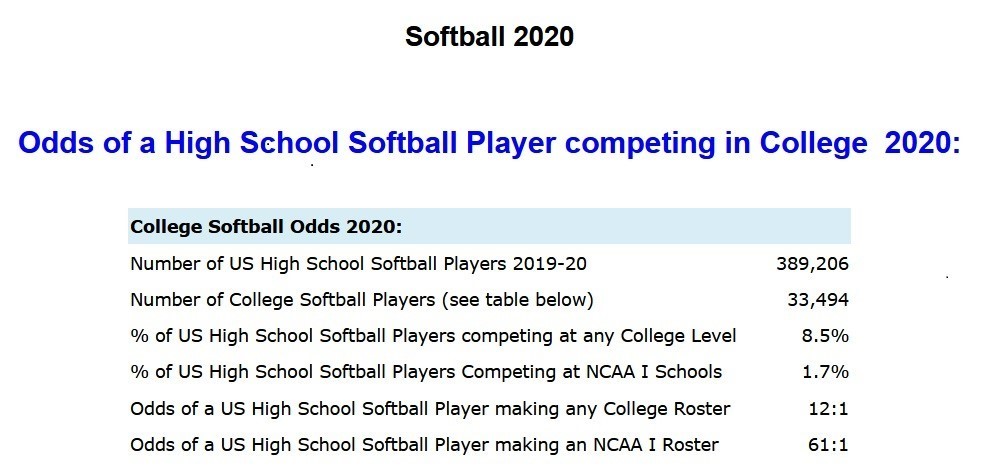
WHY RECRUITING IS LIKE A GAME OF MUSICAL CHAIRS
by Catharine Aradi
www.fastpitchrecruiting.com
It can be tough being a softball player who not only has the ability to compete in college, but who also really loves the game and can't imagine quitting after high school. The chart at the end of this article shows just how competitive it is to make a college team! To make matters worse, coaches who do a lot of off-campus scouting (and/or who run lots of camps), may have the opportunity to see thousands of players over the course of a year. Talk about a "can't see the forest for the trees" situation!
Yet, too many parents assume that every coach they pass at a major tournament is there just to see their daughter...and no one else. In the same way, many families believe that the coach their daughter is emailing every two weeks with updates on her high school statistics or her travel team’s next event is only reading her emails. That might be the case at a really small program, but in my experience, most players tend to aim high when they start their college search. In so doing, they may forget to cover their bases by aiming lower as well. Ten or fifteen years ago, this wasn't as big of a problem because you had time to work your way through 50 or 60 colleges until you found the one that wanted you. Even players who started as seniors could usually find a team to recruit them. But these days, it’s important to have—-at least—-laid out your college search game plan by the time you’re a sophomore or junior.
In my book, I refer to a "target zone." The target zone will differ, of course, for each athlete, but in general, it represents a range of college teams where you might be able to compete. On one end of this spectrum are the schools where you'd probably have to try out as a walk-on and then fight for a spot on the team. If you were lucky enough to make it, you'd probably be a role player and not get a lot of time on the field. On the other end of the target zone will be those schools that would consider you a major impact player and whose coaches would probably do everything possible to recruit you.
Most moms and dads, of course, want to see Susie playing at Alabama or Arizona (or their regional equivalent.) But as I so often remind families, only 100-150 athletes total will go to a Top 25 D-I program each year. That translates to roughly 4-5 kids per team out of thousands of high school senior ball players. And, due to the growth of softball around the United States, coaches at the big name schools can choose from the best prospects in Florida, Missouri, Georgia, Texas, and so on, and not just from the West Coast.
Children growing up in the last century (aka the 1900’s) used to play a game called Musical Chairs. A row of chairs would be set up in the middle of the room, and the number of chairs would always be one less than the number of youngsters playing the game. The person running the game would put on a record---you know, vinyl---or a cassette tape, (or if you want to go way, way back, would play a piano), and the kids would march around the chairs until the music suddenly stopped. At that point, everyone scrambled to get a seat. The player left standing was out of the game. A chair would be taken away, and the whole thing would start over, continuing until there was just one child left on one chair. She was the winner.
College recruiting is a much tougher version of this game. There are a lot more kids than there are spots on college teams. And every time the music stops—-or a player commits—-another chance at playing in college is gone. This is not to say you should grab the first school that comes along if it's not going to be a good collegiate fit for you.
But look at it this way. When you pursue only big name programs or schools whose coaches might not consider you an impact player, you're walking around four or five chairs with hundreds of other kids. If you identify and pursue colleges whose coaches will go "Wow!" when they know you're interested in them, you might end up walking around those four or five chairs with only a few other kids. Seems like much better odds to me!
When you begin your college search, don't just write the schools you saw on ESPN. Do some research and write schools that are strong at the Div. II, the Div. III and the NAIA level as well. Always keep in mind that—-despite what other parents and travel coaches may tell you—-full rides are a rarity. So for most athletes, the time will come when they have to decide whether to grab this great chair in front of them or keep marching and risk having nowhere to sit at all. In other words, if you are realistic about where you can play, it will significantly increase your chances of making your collegiate softball dream come true!
© Collegiate Softball Connection 2022